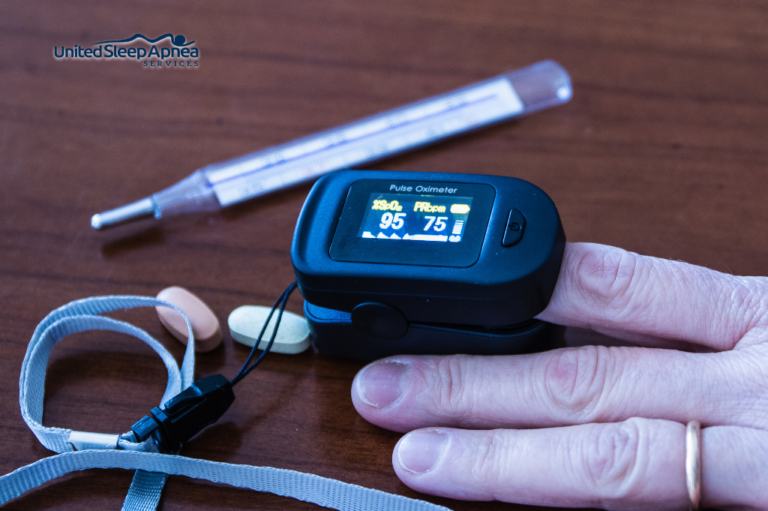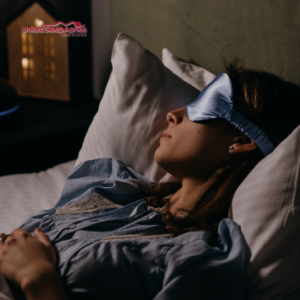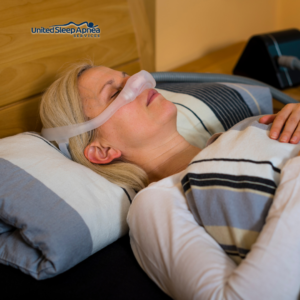
Nocturnal hypoxemia is a state where the oxygen level in the blood drops below normal during sleep. It is a sleep-related breathing disorder that may result in symptoms like shortness of breath.
Diagnosing nocturnal hypoxemia involves using the oxygen level in an arterial blood sample or measuring blood oxygen saturation during sleep with non-invasive pulse oximetry.
The pulse oximeter typically provides a normal reading range of 95-100%, and a reading below 90% indicates low blood oxygen levels.
Various factors that affect the continuous supply of oxygen to cells and tissues in the body are:
- The amount of oxygen present in the air
- The ability of the lungs to inhale oxygen and exhale carbon dioxide
- The ability of the bloodstream to circulate blood to the lungs and carry oxygen throughout the body
A problem in any of these factors may cause hypoxemia. When the blood oxygen falls below normal levels, a person may experience headaches, shortness of breath, or restlessness. Some common causes of nocturnal hypoxemia are:
- Anemia
- Asthma
- Acute Respiratory Distress Syndrome
- Congenital heart disease
- Chronic Obstructive Pulmonary Disease
- Pneumonia
- Interstitial lung disease
- Pulmonary embolism
- Pulmonary edema
- Pneumothorax
- Emphysema
- Sleep Apnea
Nocturnal hypoxemia is a sleep-related breathing disorder that impacts the quality of sleep and can be a reason for the development of other sleep disorders.
The Effect of Nocturnal Hypoxemia on Sleep
Sleep is a periodic state, which is essential for rest and repair of the body. During sleep, voluntary respiratory control is absent. Sleep plays a vital role in overall health throughout life. Getting quality sleep at the right time can help protect physical and mental health.
The quality of sleep you get greatly affects how you wake up. A night of good sleep helps you stay fresh and relaxed during the day, while experiencing disturbances and poor sleep can leave you feeling exhausted and tired throughout the day. During sleep, the body goes to repair mode, supporting healthy brain functioning and maintaining physical health.
During the episodes of nocturnal hypoxemia, the quality of sleep hampers badly. Measuring the quality of sleep is a complex task. The following factors determine sleep quality:
- Sleeping within 30 minutes of getting into the bed
- Sleeping throughout the night, waking not more than once during the sleep
- Getting the recommended amount of sleep based on your age group
- If a person wakes up in the middle of the night, they fall asleep within 20 minutes
- Feeling rested, energized, and relaxed upon waking up

Sleep is classified into two phases: Rapid Eye Movement (REM) sleep and Non-Rapid Eye Movement (NREM) sleep. During the rapid eye movement phase, breathing is slow and irregular. The oxygen saturation is usually lower in REM sleep than during NREM sleep. That’s why REM sleep generally shows a higher occurrence of hypoxemia compared to non-rapid eye movement sleep. It is lower than arterial oxygen saturation during awake, and hypoventilation further decreases arterial oxygen saturation.
During sleep, the ventilatory response to hypoxemia reduces, which differs by gender. Regardless of gender, the ventilatory response to nocturnal hypoxemia decreases further during REM compared to NREM sleep. In a study on males, ventilatory response decreased during NREM sleep than during awake. However, there was no change in the level of ventilatory response during NREM sleep and awake state. The study confirmed that the difference in oxygen saturation during REM and NREM sleep depends on the severity of sleep-related breathing disorder.
Diagnostic methods like overnight polysomnography and HSAT tests of patients suffering from nocturnal hypoxemia show that sleep quality decreases during the episodes of hypoxemia.

ARE YOU MISSING OUT ON THE MOST RESTORATIVE SLEEP OF YOUR LIFE?
Reduce your daytime fatigue with the latest diagnostic testing and physician services for improved health.
Our team of experts will listen to your concerns, guide you through the process, and answer all your questions.
The Effect of Nocturnal Hypoxemia on Sleep Disorders
Abnormal breathing during sleep characterizes sleep-related breathing disorders (SRBD). These disorders are grouped as follows:
- Central Sleep Apnea or CSA
- Obstructive Sleep Apnea or OSA
- Sleep-related hypoventilation
- Nocturnal hypoxemia
During the episodes of nocturnal hypoxemia, the blood oxygen level in the body decreases below normal during sleep. It plays a role in developing various sleep disorders like sleep apnea. Understanding how nocturnal hypoxemia affects sleep disorders and sleep-related breathing disorders is important.
Insomnia
In patients with cardiovascular disease, nocturnal hypoxemia is comorbid with insomnia-like symptoms. Insomnia-like symptoms in patients with CVD link to the pathogenesis of nocturnal hypoxemia. However, nocturnal hypoxemia with a blood oxygen level of less than 90% during more than 1.5% of the sleep time may cause insomnia. Hence, chronic nocturnal hypoxemia can lead to the development of insomnia.
Obstructive Sleep Apnea (OSA)
The collapse of the upper airway during sleep characterizes sleep apnea, a chronic sleep disorder. This results in a decreased airflow associated with a fall in oxyhemoglobin saturation. Gas exchange during sleep might severely affect certain patients with sleep apnea, especially those with obesity or chronic respiratory diseases like COPD.

Obstructive sleep apnea, a chronic disorder, associates with mortality and morbidity, including cardiovascular, neurocognitive, and metabolic diseases, and increased deaths due to cancer.
Repeated episodes of hypopneas and apneas linked to recurring episodes of hypoxemia, intrathoracic pressure changes, and arousal from sleep characterize this sleep-related breathing disorder.
Reports significantly associate hypoxemia with patients who have Obstructive Sleep Apnea. On the other hand, nocturnal hypoxemia plays a vital role in the development of sleep apnea.
In patients with sleep apnea, it is important to understand the factors that cause nocturnal hypoxemia. These factors include:
- The number and length of sleep apneas
- Oxyhemoglobin saturation (SaO2)
- The rate of fall of oxyhemoglobin saturation during each episode of apnea
Several factors affect the length and number of apneas during sleep. For instance, body weight, obesity, and drugs affect the length and number of apneas.
Patients with obstructive sleep apnea (OSA) have intermittent desaturation of oxygen associated with apnea episodes. Oxygen saturation levels under 90% are harmful. Typically, the focus of treatment is on diagnosing and reducing the negative outcomes of sleep apnea, which then, in turn, treats hypoxemia.
Intermittent nocturnal hypoxemia is a major factor contributing to the pathogenesis of sleep apnea-related comorbidities. Episodes of hypoxemia with reoxygenation characterize OSA-related hypoxemia differing from low-frequency hypoxia and potentially causing ischemia-reperfusion injury. Intermittent hypoxemia promotes oxidative stress by increasing the production of reactive oxygen species and angiogenesis, increasing sympathetic activation and vascular inflammation.
In nocturnal hypoxemia patients with OSA symptoms, cognitive impairment includes daytime sleepiness, mild cognitive impairment, and other behavioral deficits.
In older women suffering from OSA and nocturnal hypoxemia, dementia and cognitive impairment are more common than in those with no OSA symptoms. Apnea Positive Pressure Long-term Efficacy Study also correlated mild cognitive impairment in OSA patients with the severity of hypoxemia.
Hypoxemia, one of the major factors of OSA development, depresses the central nervous system and weakens the respiratory load, and dyspnea in patients with asthma. It may delay the nervous system’s reaction time after visual, thermal, and auditory stimulation. Moreover, nocturnal hypoxemia can also stimulate neurotransmitters like adenosine, endogenous opioids, and gamma-aminobutyric acid. They may be the reason for a depressed central nervous system response.
In a study, 43 patients with OSA and nocturnal hypoxemia with oxygen levels below 90% who couldn’t undergo CPAP or surgical therapy for apnea with oxygen supplementation overnight. Observations occurred for Obstructive sleep apnea symptoms before and 30 days after starting the treatment. A polysomnography study recorded the Respiratory Disturbance Index (RDI) score and minimum oxygen saturation level of 21 patients when they breathe room air or 4L per minute of oxygen through the nasal cannula. OSA symptoms significantly improved and the ESS score decreased after oxygen supplementation.
Overnight Polysomnography showed that oxygen administration helped increase the minimum oxygen saturation significantly. The RDI, however, didn’t change much with oxygen treatment. Oxygen administration to treat obstructive sleep apnea-related nocturnal hypoxemia was effective in reducing the symptoms of OSA. Oxygen supplementation had positive effects on levels of minimum oxygen saturation. Hence, oxygen treatment can prove beneficial for patients with comorbidity of OSA along with nocturnal hypoxemia.

ARE YOU OR YOUR LOVED ONES AFFECTED BY SLEEP APNEA?
Our process is designed using a patient-centered, holistic curative model that focuses on lowering costs while improving outcomes.
We serve veterans, minorities, families, and those who can’t get tests done at other facilities
Central Sleep Apnea (CSA): A Key Sleep Disorder Affected by Nocturnal Hypoxemia
Central Sleep Apnea (CSA), often associated with nocturnal hyposxemia, is a sleep-related breathing disorder in which the breathing stops and repeatedly starts during sleep. The sleep disorder results in an absence or insufficient air ventilation. Compared with obstructive sleep apnea, where ongoing respiratory efforts are observed, CSA is the lack of respiratory drive during airflow cessation. However, considerable overlap in the pathophysiology and pathogenesis between OSA and CSA exists, making it difficult to distinguish between the two sleep-related breathing disorders. CSA includes complications like frequent nighttime awakening, increased risk of chronic cardiovascular diseases, and daytime sleepiness.
The International Classification of Sleep Disorders has classified Central Sleep Apnea disorders into different types:
- Idiopathic CSA: It is a rare disorder with unclear etiology. Idiopathic CSA is a diagnosis of exclusion, as other causes of CSA will be excluded in this type. The disorder is common in elderly male patients.
- Cheyne-Stokes Respiration: It is a breathing pattern in which the patients may observe cycles of crescendo-decrescendo changes in the volume by Central Sleep Apnea. A cycle of apnea, hypopnea, hyperpnea, and hypopnea may lead to the next apnea, which usually takes a minimum of 45 seconds. For diagnosing Cheyne-Stokes Respiration, at least 10 minutes of cycles need to be recorded.
- CSA due to drugs: This type of Central Sleep Apnea is found in 30% of people who take drugs and narcotics.
- CSA due to medical condition: If a person has an underlying medical condition like degenerative demyelinating, vascular, neoplastic, brainstem malformation, injury to the brainstem, endocrine disorders, myopathies, or renal failure, this type of Central Sleep Apnea may occur.
- High Altitude Breathing: Periods of Central Sleep Apnea or hypopnea cycles with periods of hyperpnea may appear at an altitude of more than 7600 meters.
Nocturnal hypoxemia during Central Sleep Apnea may worsen the CSA symptoms. It may result in the pathogenesis of various chronic diseases like cardiovascular diseases, myocardial ischemia, Chronic Obstructive Pulmonary Disease (COPD), and congestive heart failure.
How Nocturnal Hypoxemia Influences Periodic Limb Movement Syndrome and Restless Leg Syndrome
Restless leg syndrome (RLS) may appear along with nocturnal hypoxemia. A strong correlation with the severity of restless leg syndrome suggests a pathophysiologic relation between nocturnal hypoxemia and symptoms of restless leg syndrome.
Periodic limb movement (PLM) during sleep and nocturnal hypoxemia is associated with an increased risk of death in patients with End-Stage Renal Disease (ESRD). Sleep-related breathing disorders like sleep apnea and nocturnal hypoxemia, along with periodic limb movement during sleep, can be seen commonly in patients with ESRD. The prevalence of sleep-related breathing disorders (SRBD) is 40-80% in patients with ESRD.
Nocturnal hypoxemia, along with PLMS, in patients with ESRD increases the risk of the pathogenesis of left ventricular hypertrophy, coronary artery disease, and cardiovascular diseases.
Parasomnias: The Role of Nocturnal Hypoxemia in These Sleep Disorders
Parasomnias are sleep disorders that cause abnormal behavior or movement during sleep. Various parasomnias are:
- Sleepwalking
- Groaning
- Nightmares
- Sleep talking
- Sleep paralysis
- Teeth grinding
- Jaw clenching
- Bedwetting
Parasomnias, combined with other sleep disorders like sleep apnea and nocturnal hypoxemia, may become fatal and cause chronic medical conditions, including paralysis, atrial fibrillation, and more.
Conclusion: The Broad Impact of Nocturnal Hypoxemia on Sleep Disorders
Nocturnal hypoxemia is a sleep-related breathing disorder where the blood oxygen drops below normal levels during sleep. It can be diagnosed by measuring blood oxygen levels using overnight pulse oximetry. Sleep disorders are diagnosed by overnight polysomnography and HSAT tests.
Nocturnal hypoxemia affects sleep and worsens the symptoms of sleep disorders. It is a major contributor to the pathogenesis of various sleep disorders, including Obstructive Sleep Apnea, Central Sleep Apnea, insomnia, and more. Nocturnal hypoxemia combined with sleep disorders may result in the development of chronic medical conditions, including congestive heart failure and Chronic Obstructive Pulmonary disease.